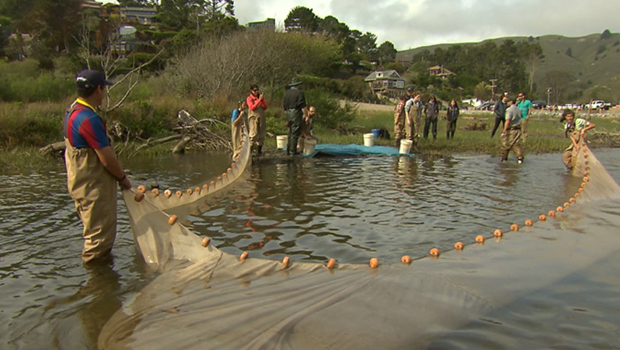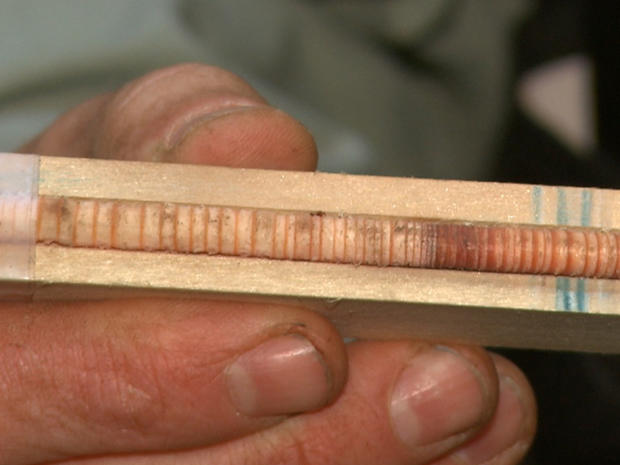Surveying species among California's redwoods
What better way to spend Sunday on a holiday weekend than taking a walk in the woods -- the redwoods, to be exact. Carter Evans will be our guide:
"In every walk with nature, one receives far more than he seeks" -- fitting words from America's most famous naturalist, John Muir. He was known as "the father of America's national parks."
Recently a new generation of natural "wanderers" embarked on a monumental task in the national monument named in his honor, the Muir Woods.
"Enjoy the rain, we're all going to get wet," said Glenn Plumb, chief wildlife biologist for the National Park Service.
He led a team of grade-schoolers into the woods armed with a video camera on a pole: "Now the fun thing about this is, we don't know exactly what we're going to find."
Plumb and his volunteers were part of a bold effort called a "bioblitz" -- a 24-hour inventory of every species living in the 116-square-mile area. It was organized by National Geographic and the National Park Service.
More than 300 scientists led swarms of school kids, families and volunteers on a mission to count every type of plant, animal and insect.
Plumb's part in the cataloging was to see if they could videotape bats sleeping deep in the hollows of giant redwoods.
Evans asked, "What would be one of the tell-tale signs that a bat has been here?"
"It could be guano, smear of guano," said Plumb. "Where there's guano, there's bats!"
Stretching from the edge of San Francisco to the towering redwoods of Muir Woods, the Golden Gate National Recreation Area receives 14 million visitors every year. But what scientists want to know is not who visits; rather, what calls the parks home.
Marine biologist Michael Reichmuth led his team of amateur scientists to Muir Beach, where the Redwood Creek meets the Pacific Ocean. "Normally, you'd have park rangers like me yelling. 'Get back on the trail,'" Reichmuth said. "But today you have a free pass!"
Wading through the mud and brackish water in these newly-restored tidal lagoons, their goal was to tally every fish in their trawl. Found were plenty of baby sculpin and sticklebacks -- fish that have adapted to live in both the ocean and fresh water.
"When I see this, I think I actually see the kids making a connection with their natural resources," Reichmuth told Evans. "They're seeing that they actually do have fish in their backyard. And I think they get excited about it."
Above it all was Steve Sillett, just hanging out -- 25 stories above the ground. The professor of ecology at California's Humboldt State was part of the first team ever to survey the tops of these giant redwoods.
He showed Evans a "small tree" -- a mere 76 meters. "The tallest tree is almost 116, and still growing.
"When you can get out in the woods, and particularly if you can get up into the canopy, in such a large organism, there's a point where you lose sight of yourself, and there's a real calm that comes over."
Hundreds of feet above the ground, Sillett counted more than 40 different species of lichen dripping from the redwoods' branches; and he studies the trees' growth rates by taking core samples.
"We punch a hole in the trunk and pull this piece of wood out," he demonstrated. "And the history of the tree's growth at this height is revealed here."
It is, Sillett agreed, like looking at a history book. "That's what's cool about trees; they record everything that happens to them in the rings."
In all, the scientists, students and volunteers recorded more than 2,300 different types of plants and animals, including a mountain lion, all right in San Francisco's backyard.
"You don't have to be a professional scientist to do this," said Plumb. "You can be a citizen scientist. And discovering the biodiversity of your national parks is truly an American experience."
This year marks the 100th anniversary of John Muir's death, and the world has dramatically changed. But somehow the magnificent redwoods -- and the forest that bears his name -- have adapted and thrived.
"The mere scale of this ecosystem humbles," said Sillett. "We think we're so damned important, and you walk in here, and you realize you're just a tiny little creature. We only have these tiny little life spans compared to these trees.
"And yet, they never can move. Look what they can do standing in one place for 1,000 years!"
"What could we learn from them?" asked Evans.
"A lot, I think," Sillett replied.
For more info:
- Muir Woods National Monument
- Golden Gate National Recreation Area
- BioBlitz (National Geographic)
- National Geographic Society
- Save the Redwoods League
- Follow Save the Redwoods League on Twitter, Facebook and Flickr
- "A Family Guide to the Coast Redwoods" (from Save the Redwoods League)
- Professor Stephen Sillett, Humboldt State University


